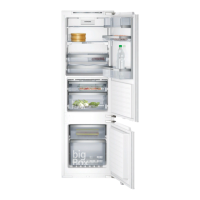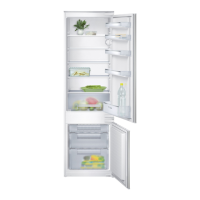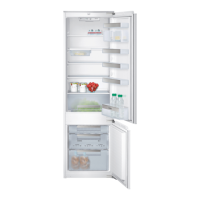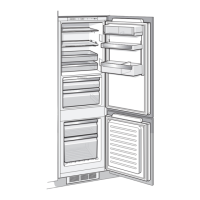Do you have a question about the Siemens KI34NP60 and is the answer not in the manual?
Instructions for environmentally friendly disposal of packaging materials.
Guidelines for the environmentally sound disposal of used electrical appliances.
Essential reading before putting the appliance into operation, covering installation and usage.
Covers refrigerant safety, electrical connections, and potential hazards.
Important safety precautions for using the appliance, including electrical risks.
Identification and function of buttons and displays on the control panel.
Guidelines on ambient temperature ranges for optimal appliance performance.
Requirements for appliance placement and proper ventilation for efficient cooling.
Instructions for connecting the appliance to the power supply safely and correctly.
Steps to power on the appliance and initial status indicators.
How to adjust and set temperatures for refrigerator and freezer compartments.
Explanation of door and temperature warning signals and their meanings.
Recommendations for proper food packaging and storage to maintain freshness.
Understanding the different temperature zones within the refrigerator for optimal food storage.
Instructions for adjusting the height of shelves and drawers for flexible storage.
Details on shelves, drawers, and bottle holders within the refrigerator.
Information on the ideal storage conditions and uses for the refrigerator compartment.
How to activate and use the super cooling feature for rapid chilling.
Guidelines for using the freezer compartment for storing frozen food and making ice.
Proper techniques for freezing fresh foods to preserve quality and nutrients.
Advice on purchasing and storing frozen food items correctly.
Instructions on how to correctly wrap and label food for freezing.
How to activate and use the super freeze function for optimal freezing results.
Details on special features like cold accumulators and ice trays.
Methods for safely thawing frozen food items.
Instructions on how to turn off and disconnect the appliance.
Procedures for cleaning the appliance interior and exterior safely.
Steps for removing and cleaning shelves, drawers, and rails.
Information about the maintenance-free LED lighting system.
Recommendations for reducing electricity consumption and maintaining efficiency.
Explanation of normal operating sounds and how to prevent unwanted noises.
Guidelines for the proper disposal of packaging and old appliances.
Crucial safety warnings and precautions for using the appliance.
Key safety rules to follow during the operation of the appliance.
Safety measures related to children's interaction with the appliance.
Identification of appliance parts and controls, including buttons and displays.
Understanding climatic classes and their effect on appliance operation.
Proper installation procedures and ventilation requirements.
Instructions for safely connecting the appliance to the power supply.
Steps to power on the appliance and initial status indicators.
How to set and adjust temperatures for the refrigerator and freezer compartments.
Explanation of different warning signals and how to respond to them.
Recommendations for arranging food within the appliance for optimal storage.
Information regarding the appliance's usable capacity.
Instructions for adjusting or changing the position of shelves and drawers.
Details on specific fittings like bottle shelves within the refrigerator.
Description of the refrigerator compartment's purpose and temperature settings.
How to activate and use the super cooling feature for rapid chilling.
Guidelines for using the freezer compartment for storing frozen food and making ice.
Techniques for freezing fresh foods to preserve quality and nutrients.
Guidance on which foods are suitable for freezing and the blanching process.
Instructions on how to correctly wrap and label food for freezing.
Information on the recommended storage times for various frozen food types.
How to activate and use the super freeze function for optimal freezing results.
Methods for safely thawing frozen food items.
Instructions for turning off and disconnecting the appliance for storage or cleaning.
Procedures for cleaning the appliance interior and exterior safely.
Steps for removing and cleaning shelves, drawers, and rails.
Information about the maintenance-free LED lighting system.
Recommendations for reducing electricity consumption and maintaining efficiency.
| Door hinge | Right |
|---|---|
| Control type | Buttons |
| Display type | LED |
| Product color | White |
| Reversible doors | Yes |
| Shelves material | Tempered glass |
| Appliance placement | Built-in |
| Door panel included | No |
| Cord length | 2.3 m |
| Noise level | 39 dB |
| Climate class | SN-T |
| Total net capacity | 259 L |
| Total gross capacity | 287 L |
| Minimum operating temperature | 10 °C |
| Fridge net capacity | 186 L |
| Fridge door balconies | 4 |
| Fridge gross capacity | 196 L |
| Multi-Airflow system (fridge) | - |
| Fridge number of shelves/baskets | 3 |
| Star rating | 4* |
| Freezer position | Bottom-placed |
| Freezing capacity | 15 kg/24h |
| Freezer net capacity | 73 L |
| Freezer gross capacity | 91 L |
| Storage time during power failure | 13 h |
| Current | 10 A |
| Power source | Electric |
| Connected load | 120 W |
| AC input voltage | 220 - 240 V |
| AC input frequency | 50 Hz |
| Annual energy consumption | 238 kWh |
| Package weight | 79000 g |
| Depth | 545 mm |
|---|---|
| Width | 556 mm |
| Height | 1772 mm |
| Weight | 74000 g |
| Installation compartment depth | 550 mm |
| Installation compartment width | 560 mm |
| Installation compartment height | 1775 mm |











